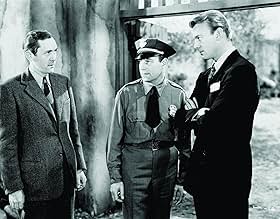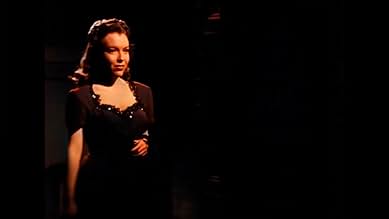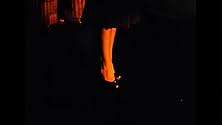Un léopard, utilisé lors d'une représentation de castagnettes, s'échappe apeuré par le bruit. Peu après, une série de meurtres touche la ville, mais, son propriétaire et le publicitaire qui ... Tout lireUn léopard, utilisé lors d'une représentation de castagnettes, s'échappe apeuré par le bruit. Peu après, une série de meurtres touche la ville, mais, son propriétaire et le publicitaire qui en avait la charge ne le croient pas responsable.Un léopard, utilisé lors d'une représentation de castagnettes, s'échappe apeuré par le bruit. Peu après, une série de meurtres touche la ville, mais, son propriétaire et le publicitaire qui en avait la charge ne le croient pas responsable.
- Réalisation
- Scénario
- Casting principal
- Récompenses
- 2 nominations au total
- Consuelo Contreras
- (as Tula Parma)
- Mexican Police Officer
- (non crédité)
- Dwight Brunton
- (non crédité)
- Nightclub Patron
- (non crédité)
- Nightclub Waiter
- (non crédité)
- Boy Singer
- (non crédité)
- Waiter Serving Helene and Dwight
- (non crédité)
- Young Lover
- (non crédité)
- Helene
- (non crédité)
- Coroner
- (non crédité)
Avis à la une
Based on the book "Black Alibi" written by Cornell Woolrich, The Leopard Man's only crime is that it's not as great as its two predecessors, Cat People & I Walked With A Zombie. Rest assured, though, this is still a quality Lewton/Tourneur production. As a story it's simple and straight, with a running time of just over one hour keeping it lean and devoid of pointless waffle, but the piece positively thrives on its atmosphere - dealing as it does in murky shadows and unease inducing periods of silence. It also boasts a number of sequences that linger long in the memory, be it blood seeping under a door, the bend of a tree branch, or the dark under belly of a railway bridge, for such a short sharp shock of a movie there's so much to enjoy. The work of cinematographer Robert De Grasse (Vivacious Lady/The Body Snatcher) is top class and worthy of indulgence from the film noir loving crowd.
What you don't see is more effective on account of the eerie sense of dread that Messrs Lewton/Tourneur/De Grasse have built up. A fine film and proof positive that classic spookers could be made from relatively small budgets. 7/10
The star players are somewhat dull, but the supporting cast is quite good. And the merging and sometime colliding of the Anglo, Hispanic and Indian cultures is nicely presented. There is a sense of primitive feeling, of old religion, throughout the film, implied rather than stated, that is beyond the grasp of the hyper-rational lead players. We can catch this mood in fits and starts, but like the major characters, it eludes our grasp. Jacques Tourneur's direction is masterful every step of the way; and he uses music sensually yet emphatically, and the result is a fine-tuned film. It's major flaw is the revelation of the culprit, yet once Tourneur accepted the script's limitations he works superbly within them. The best thing about the movie is that its most crucial events happen mostly off-screen, leaving a good deal to our imaginations. And the minimalist script leaves a great deal in the dark, and even after the picture's florid, almost surreal climax, the air of mystery lingers. There are loose ends for sure, but Tourneur's polite, civilized touch dresses them up to appear profound and suggestive rather than threadbare, and the result is a pleasing conclusion that does not quite give the whole thing away; and we are left wanting to know just a little bit more. Tourneur was a true master.
In a sleepy New Mexico town that somehow supports a posh night club, publicity man Dennis O'Keefe gets an idea to promote an act by arranging for the star (Jean Brooks) to make a grand entrance with a big black leopard on a leash. The cat escapes and soon the deaths begin.
First a girl sent out into the night to fetch cornmeal for mama's tortillas finds the corner store closed and must venture further afield. Tumbleweeds stirred up by the dry winds and trains hurtling over trellises are unnerving enough, but then something else starts its pursuit. She almost makes it back safely but the lock is stuck....
Next another young woman sets off in late afternoon for an assignation with her boyfriend at the cemetery. When he doesn't show, she loses track of time and improvidently finds herself locked in among the gravestones and statuary....
A posse sets out to find and kill the leopard, but O'Keefe begins to doubt whether the killer is in fact feline. It's in the resolution (based on a story by Cornell Woolrich) that the script ultimately disappoints, but the trip to it remains a dark ride. Those minuscule budgets didn't compromise the movie's decadently glossy looks, and the extraordinary Roy Webb's castanet-ridden score keeps the tension taut (one high, sustained, almost pianissimo chord hangs over the cemetery scene). The mistress of the castanets, a cabaret dancer called Clo-Clo, is an actress called Margo; the ace of spades keeps turning up in her fortune. Her performance lends The Leopard Man what little heart it shows.
Like other Lewton films, THE LEOPARD MAN relies more upon what it suggests than upon what it actually shows. This film is particularly effective in building suspense in a series of scenes that show various characters walking--a saucy Spanish dancer strolling along the street, a frightened teenager making a night-time trip to the grocer, a young woman rushing through a cemetery at night. The cinematography is elegant in its simplicity, and the sound design is quite remarkable. Hard to find, but Lewton fans will find it worth seeking out.
Gary F. Taylor, aka GFT, Amazon Reviewer
Le saviez-vous
- AnecdotesIn the Summer of 1952, RKO reissued this film as a double feature with King Kong (1933). RKO cashed in, as young theatergoers, due to this film's title, were expecting to see a second creature film.
- GaffesAt the nightclub, Kiki is seated at a table with Jerry and Galbraith. As she asks Galbraith why he gave up teaching, a slim dark-haired woman wearing a matching suit and hat walks past their table. The shot cuts to Galbraith saying 'Various reasons', and the woman can be seen behind him (just over his shoulder on the far left of the screen), already seated at a nearby table.
- Citations
Charlie How-Come: You don't get the idea, mister. These cops banging those pans, flashing those lights, they're gonna scare that poor cat of mine. Cats are funny, mister. They don't want to hurt you, but if you scare them they go crazy. These cops, they don't know what they're doing.
- Versions alternativesSome older TV prints of "The Leopard Man" run 59 minutes.
- ConnexionsFeatured in Terror on Twelve: The Leopard Man (1964)
- Bandes originalesLas Mañanitas
(uncredited)
Traditional Mexican birthday song
Performed by Fely Franquelli and Ottola Nesmith
Meilleurs choix
Détails
- Durée
- 1h 6min(66 min)
- Couleur
- Rapport de forme
- 1.37 : 1
































